National Non-Profit Day Spotlight: Four Fantastic Texas-Based Organizations

According to the National Center for Charitable Statistics, there are over 1.5 million non-profits registered in the United States. This list consists of educational, public safety, and charitable causes. Every year, on August 17th, National Non-Profit Day recognizes the missions of these organizations across the nation. The goal behind this day is to educate and empower our local communities to make a positive impact on the world. We had some conversations with four of our non-profit clients to learn about their experiences in the sector.
PAL®
Having teamed up with the Workers Assistance Program in the past, WEBii has been ecstatic to kick off the website redesign project for PAL® (Peer Assistance and Leadership). It showcases itself as a transformational—and fun—opportunity for fostering positivity and stronger decision-making skills. The PAL program can be found in elementary, middle, and high schools across the country. Essentially, they are building a better tomorrow for the youth of today.
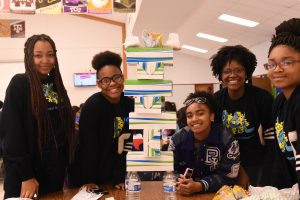
Photo courtesy of PAL®
Q&A with Stacy Pritt, CST Director
Tell us a bit about how PAL came to be.
“PAL® Peer Assistance and Leadership is an award-winning, Nationally Recognized Evidence-Based Prevention Program owned and operated by the non-profit organization, Workers Assistance Program, Inc. (WAP). PAL® began in 1980 as a peer mentoring program, commonly referred to as “peer helping,” by combining peer assistance and peer leadership strategies. PAL® applies these basic prevention strategies by implementing the program as informal, extra-curricular activities, or as structured, evidence/curriculum-based programs.”
Explain what the mission of PAL® is.
“PAL® was built with the mission to create better schools, workplaces, and communities. We recognize the innate capacity for social understanding, personal wellbeing, and community participation in every student. The PAL® program channels the potential of youth to make a difference in their lives. Course content and interactive activities nurture and build skills that support youth in developing protective factors which help them achieve school and social success. These changes have been demonstrated to persist and become enhanced well beyond the completion of the program.”
What inspired you to become part of PAL®?
“Being part of a program that helps positively shape the lives of our youth and set them up for success. I love helping others in any way I can, and seeing the long-lasting trickle effect our program has not only on our students but their families and their communities has been beyond amazing!”
What is something that people may not know about PAL®?
“While our program is primarily implemented in schools, it can also be implemented in various community organizations.”
How do you feel that the internet has changed the kinds of education and help that today’s youth is able to receive?
“I think access to learning opportunities is unprecedented thanks to technology. The internet has opened doorways to a wealth of information, knowledge, and resources; it’s increased opportunities for learning in and out of the classroom.”
What is your favorite part about being a non-profit organization based in Texas?
“While we are a national program, our headquarters are in the beautiful city of Austin and we have a large presence in Texas schools. The support and hospitality have been tremendous. What’s there not to love?!”
What are you most looking forward to about your website redesign?
“Besides a more modern look that represents us better, we are thrilled to be able to offer a more sophisticated and interactive site that will ultimately serve our clients more effectively.”
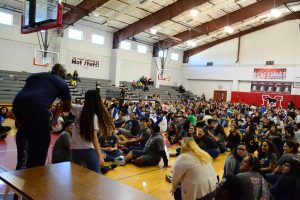
Photo courtesy of PAL®
Travis County WCID No. 17
Over 70% of our planet is made up of water. However, it isn’t the case that all of that water is drinkable. And, for that matter, not everyone knows how to properly conserve it. The Travis County Water Control and Improvement District No. 17 (WCID No. 17) is a non-profit that is committed to providing water-related services. The team behind the organization promotes the safety of the system through their active participation in the community.
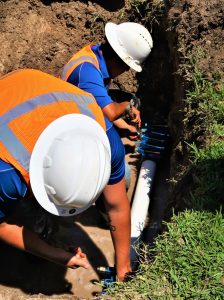
Photo courtesy of WCID No. 17
Q&A with Jason Homan, General Manager
Tell us a bit about how WCID No. 17 came to be.
“Travis County Water Control and Improvement District No.17 is a water and sanitary sewer service provider in Central Texas, servicing approximately 50,000 residents across a 26 square mile service area. The District was formed in 1959 and has steadily grown as the land within its service area has been developed. The District is governed by a five-person publicly elected Board of Directors.”
Explain what the mission of WCID No. 17 is.
“To provide the District with an adequate supply of safe, potable water and to ensure the fiscally sound, environmentally responsible development and management of water resources and wastewater facilities.”
What is something that people may not know about WCID No. 17?
“Many may not realize that District staff provide 24-hour service to our community. In the event of an outage, line break, or service issue at a residence, we have personnel on call who will be available to assist the community 24 hours a day. Our personnel work through all conditions, as long as necessary, to ensure services are maintained for our customers.”
If you had to give one piece of advice that’s related to the work of your non-profit, what would it be?
“The greatest advice we could provide to a similar non-profit would be to ensure you are investing in your long-term planning. With the many fiscal challenges public utilities face, it can be easy to concentrate your resources on meeting the issues of today, while putting off the decisions that affect the future. But, failing to adequately plan for those future issues will only increase their ultimate expense and the negative impact that they will have on the utility as well as the public it serves.
We try to ensure that we are always balancing today’s needs against those of tomorrow. We do this by investing in growth planning for our community, conservation planning on how we will be able to meet the growing community’s water needs, and technology planning on how we can service that growth in a fiscally responsible manner by leveraging the advantages technology can provide.”
How do you feel that being able to go digital has impacted how WCID No. 17 is run?
“We have found that the conversion to a digital process has sped up our workflow while also increasing our productivity. This increase in productivity, over time, will be a definite contributor to how we keep our operational costs controlled, and ultimately how we can continue to provide our services at low costs despite the current economic factors we all are facing.”
Talk about your website and what the most helpful additions people will be able to find there are.
“We have recently undergone a complete renovation of our website and its content. WEBii was instrumental in our ability to modernize our site, allowing for quick and intuitive access to our most critical information. The ability to easily provide updates and notices to our customers has greatly increased our ability to communicate with them, and as a result, we have seen a significant increase in traffic, while receiving numerous compliments from our customers on the site’s ease of use and more modern feel.”
What is your favorite part about being a non-profit organization based in Texas?
“The ability to service our customers and ensure we are providing them with the highest quality service possible. It is a great honor to be entrusted with preserving the public’s safety through the quality production of a reliable, safe, potable water and sanitary sewer service. Our employees recognize the responsibility that comes with this profession and we take great pride in doing everything within our power to meet it.”
Check out our WCID No. 17 case study from their website redesign!
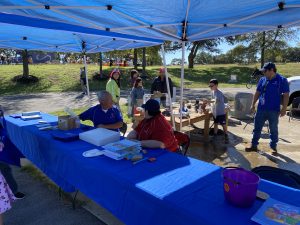
Photo courtesy of WCID No. 17
Capital IDEA
As the Executive Director of Capital IDEA, Alyssia Palacios-Woods is proud to be known as a community builder and non-profit leader. She has 12 years of experience supporting workforce development initiatives. Today, at Capital IDEA, Palacios-Woods and her colleagues can be found representing diversity at every step of the way. Throughout the organization’s website and social media channels, they can be seen uplifting their students and promoting equity.

Photo courtesy of Capital IDEA
Q&A with Alyssia Palacios-Woods, Executive Director
Tell us a bit about how Capital IDEA came to be.
“Capital IDEA was founded in 1998 in response to the needs of the booming semiconductor industry which moved to Austin in the early 1990s. Employers were struggling to find enough properly trained individuals in the local workforce which presented an opportunity to activists from a local coalition called Central Texas Interfaith. They secured the first funding for Capital IDEA which is based on the model of Project Quest in San Antonio.
Capital IDEA was created to bridge the gap between the needs of regional employers and those of Austin residents who needed good-paying jobs. Since then, Capital IDEA has developed employer and training partnerships in healthcare, information technology, trades, and applied technology careers.
Today, it costs about $5 million a year to make our program available to the community. The funding to support us comes from donors, foundations, local employers, and government agencies, including our three largest investors: the City of Austin, Travis County, and St. David’s Foundation.”
Explain what the mission of Capital IDEA is.
“Capital IDEA’s mission is to lift working adults out of poverty and into living-wage careers through education and career advancement. We envision a thriving Central Texas where non-traditional students have the opportunity to get an education, enter a skilled occupation, earn a living wage, and reach their full potential. At the same time, we aim to make it easier for our leading employers to stay, grow, and hire locally from a diverse pool of motivated workers properly trained for the best careers of today and the future.”
What inspired you to become part of Capital IDEA?
“As a community member, I have regarded Capital IDEA as a “gold star” program for the past decade. Both of my parents are first-generation college graduates, and I saw firsthand the impact of their educational attainment on their lives – and mine. When the chance to become part of the Capital IDEA team became available, I knew it was a place where I could use my experience and network to continue elevating a mission that I am personally passionate about, and that is much needed in our Central Texas community as we face big issues with affordability, gentrification, and inflation.”
What is something that people may not know about Capital IDEA?
“In addition to supporting a long list of careers in healthcare, we also support careers in IT – web development, network administrator, and computer support specialist. We are always looking for employers who can provide internships to our students and find that many of those internships lead to successful job placements. If you’re interested in being an employer partner, please get in touch! You can use the contact form on our website and ask to be put in touch with our Senior Employer Coordinator, Ron Modesty.”
How do you feel that the rise of digital marketing has changed what it’s like to run a non-profit organization?
“I believe the rise of digital marketing has offered more opportunities to directly reach target markets, spurring non-profits to invest more time and resources into honing their marketing strategy and messaging like never before. Non-profits are vying for views and engagement alongside for-profits, and have to get strategic about where, when, and how they use digital marketing to accomplish outreach goals on a budget.”
What is your favorite part about being a non-profit organization based in Texas?
“Texas is a big supporter of workforce development at different levels of government. This funding is critical to continue work locally and across the state to move people from low-income to high-paying, high-demand careers, changing the trajectory of their and their families’ lives. Every dollar invested in Capital IDEA has a $5 return on investment, a win-win for our community.”
Take a look at our Capital IDEA case study on their web development project!
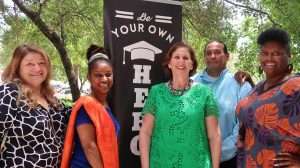
Photo courtesy of Capital IDEA
Pflugerville Fire Department
Do you not know what to do in the event of a fire? Are you interested in becoming a volunteer firefighter? What about getting your property inspected for safety and compliance? The Pflugerville Fire Department website has everything that you need to know. Since it was chartered in 1955, the department has continued to grow into the five round-the-clock, live-saving fire stations we see today.
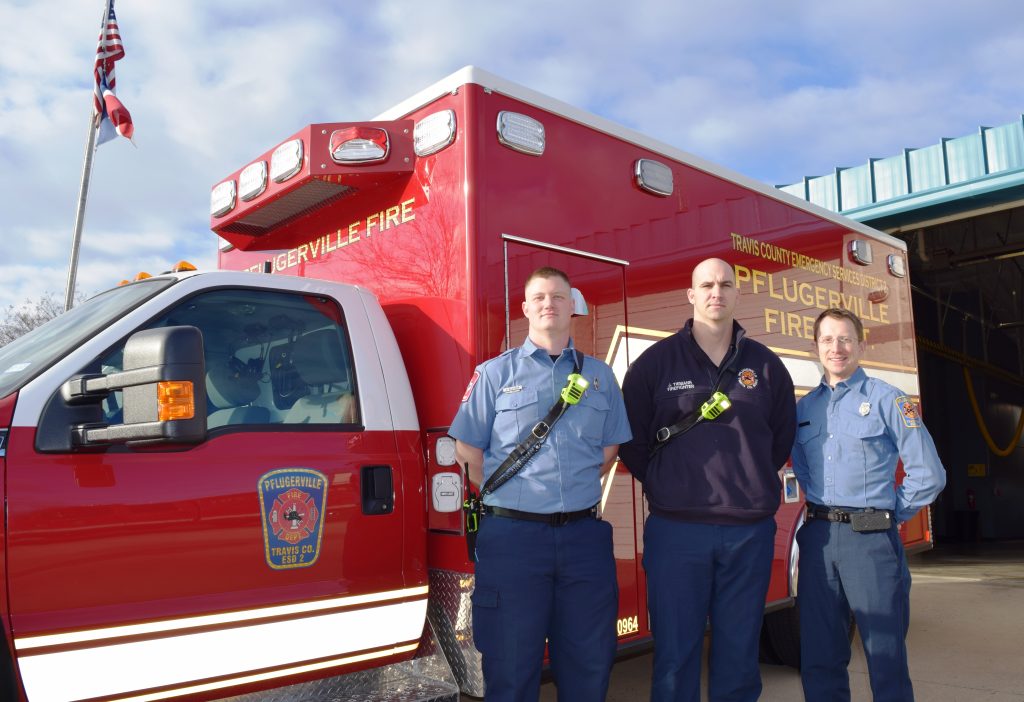
Photo courtesy of the Pflugerville Fire Department
Interview with Nicholas Perkins, Fire Chief
Megan: As a firefighter, obviously a major part of your job is fighting fires, hence the name. So, I’m sure that you’ve found yourself in plenty of extremely high-stress situations. I know that I personally would never be able to do it. But what inspired you to become a part of the Pflugerville Fire Department? Did you always want to be a firefighter?
Nicholas: For as long as I can remember, I was fascinated with the fire department. Fire department and garbage men—I think it was because they road on the back of trucks. I grew up being interested in that and really just never wanted to do anything else. I got some exposure from a family friend who was a firefighter, and he actually let me come to work with him a few times. It really just solidified my decision to become a firefighter.
Megan: Awesome. So, I’d love to know more about your role is, specifically, at your fire department. I know that you’re the Fire Chief, but what does that entail? What does a day in your life look like?
Nicholas: I just took over in October of last year. I’m a new Fire Chief, although I’m not new to the fire service. I’ve been doing this for 25 years. I’m responsible for oversight of the fire department. That’s everything—operations, finances, planning, admission, execution, and completion. And so the way I do that is, number one, I’ve got to rely on my staff. Everyone from the firefighters on the ground delivering the critical service to supervisors and the support staff that we have that support our ability to achieve the mission.
Really, my job is communicating and leading. We use Google Suite so I have access to some data, and I average 37 hours per week in meetings. I’m meeting with different groups every day, from the firefighters on the ground to the administrative staff.
And then a big part, if not half of it, is communicating with the community. We have a lot of stakeholders that we engage with. For example, the school district. I don’t think a lot of people realize how much we interface with the school district, from a partnership aspect, meaning we have a similar kind of mission that we serve the community. And we have a lot of cross-over with school security being a big thing.
But for us, we’re actually a separate entity. We’re not part of the city of Pflugerville. We’re our own emergency service district. So, we interface with, like I said, the school district, the city of Pflugerville, Travis County, and then several other neighboring agencies, like fire waste and EMS. I spend a great deal of time meeting with those people and communicating.
Megan: As a digital agency, we know a lot about communicating and having to go to constant meetings throughout the day. So, we very much relate to you on that level. But, also as a digital agency, we think it’s very important for every business and non-profit organization to have a website and social media. Using these, you’re able to tell the public everything that they need to know about who you are and what it is that you do. What do you think is the most important part, for the Pflugerville Fire Department, when it comes to having an online presence?
Nicholas: It’s a great question, and it’s something that kind of dominates the discussion with my bosses. I report to a board of five citizens that oversee the fire department. And the theme that we’re always talking about is telling our story. Fire departments traditionally are kind of slow to adapt to change and technology. So, we’re like a 2,000-year-old business where, at the end of the day, we put wet stuff on the red stuff. A lot has changed, but a lot hasn’t.
I was speaking to a group of about 300 people here a couple of weeks ago and I was like, “Raise your hand if you plan to call the fire department this year.” And two people raised their hand. If I run the numbers, we serve about 160,000 people and we do over 13,000 calls a year. So, in a room of that size, there’s going to be about ten people who are going to call us, and that’s a conservative estimate.
It’s really hard to, for example, convince a group of people we need help, like funding, for a service that they believe they are never going to use. It’s a challenge. So, we have to tell our story. We have to tell what we do. We have to make sure people understand that we’re out there.
The other thing I think working against us is that we don’t like attention. So, we really would prefer to remain in the background. A lot of this stuff is just kind of unnatural for us as firefighters at the core. You add in the technology. We’re the last people to implement technology just because we’re—I use the term—knuckle-drive firefighters. And, like I said, we just have this challenge of people thinking, “I’m not going to have an emergency. I don’t need the fire department.” So, I think for us, having a website, having a medium to communicate, is absolutely critical.
And then it’s just the work of actually communicating and being consistent and meaningful. All of the challenges that you all are familiar with. How do you get people’s attention in today’s world when there’s just so much information out there?
Megan: One of the primary goals of your job is to keep a community safe and have a healthy place to live, work, and visit. I think that’s what it directly says on your site, actually. But one of the things that is offered on your site, in regard to that, is about community risk reduction. So, thinking about that, what is one piece of advice that you would give to someone in regard to fire safety?
Nicholas: The community risk assessment—we’re actually going through the process of reupdating it, since we reupdate that every few years. It’s how we direct our programs and make decisions to allocate resources.
But my piece of advice for people… The greatest fire risk that we see in the community is going to be in single-family dwelling homes—so, people’s houses. And then we have multi-family—people who live in apartments. On the apartment side, we actually have fire code ability, so we can go into those buildings and make sure that there is a working smoke alarm and that fire hazards are addressed. In people’s homes, we have no fire code ability. We are 100% relying on those people who live in those homes to be responsible for their own fire safety. So, my message is, number one, you have to have a working smoke alarm. We know that if you have a working smoke alarm, it gives you early notification in the event of a fire. And it decreases your chance of dying in a fire, or increases your chance of surviving in a fire, by 50%.
And then it’s just to have a plan. It’s not something you have to do every single day and talk about every single day, but it would be good as a family to sit down and say, “Hey, if the house was to catch on fire, what would we do?” It’s as simple as understanding how to get out of doors, maybe even how to get out of a window. And then where are we going to meet when we get out.
What trails behind that is disaster thinking and disaster preparing, which can be generally stated to cover all of the wide arrays that a community could face. And that includes having a plan, having a kit—a backpack with supplies to last you for like three days. It includes things like medication, important contact information, potentially a little bit of cash.
Megan: Well, I’m definitely going to take those tips into consideration. I know I need to be more on top of things. I’m curious, outside of the online world, what is something that people may not know about the Pflugerville Fire Department? Does your team have any traditions? Or what makes you unique from another fire department?
Nicholas: There’s a really big fire department in the country and their motto is, “200 years of service unimpeded by progress.”
The reality is, 70% of the calls that we receive for help are medical calls. We should really be “the fire and medical department,” or really the “medical department.” Every career firefighter in the state of Texas, and across the country, we’re all emergency medical technicians. So, we’re primarily healthcare providers who occasionally fight fires. That’s an entire paradigm shift that I don’t think is well-known or understood.
We’ll get questions like, “How come when there’s an ambulance, there’s a fire truck?” Number one, there’s more of us. We get there faster, we provide care. Typically, on a fire truck, at least three to four people show up. An ambulance only has two. And if you’re really sick, you need all of those people working on you. I like to say, if you went to an ER, would you expect just one person to take care of you if you’re really sick? No, you want everybody in the world coming to help you.
For our fire department, in particular, we provide fire-based EMS. So, we actually provide ambulance service, as well, for part of our district where funding is provided. Healthcare continues to be this incredibly expensive enterprise for the world and for our country. And so, looking for ways to continue an essential service but also minimize the cost… The fire department stands in the middle. We already exist in communities. We are already trained medical providers. We just need the ambulances and the funding that can support that.
Megan: So, the last question that I have before we wrap things up here is what is your favorite part about being a non-profit organization based in Texas?
Nicholas: The core part of what we do is help people. In addition to getting to ride on the back of a truck, it’s just being able to answer the basic question of what Martin Luther King posted years ago… “What are you doing for other people?” When you’re a firefighter, you can say, “I’m doing all kinds of stuff for people.” That’s what I like about it.
The Texas part of it… In Texas, we have our own way of thinking. We have our own culture in this state. It’s beautiful, it’s unique, and it’s well-known. I’m going to be going to some conferences over the next couple of weeks and everyone knows I’m from Texas. It’s connected to the helping people, too. I think Texans are known for being friendly and we’re known for being helpful, so it all kind of plays together.
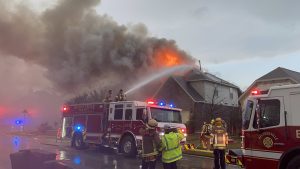
Photo courtesy of the Pflugerville Fire Department
The team at WEBii wants to say happy National Non-Profit Day to all of the organizations that are being the change they wish to see. If you want to get in involved with any of our non-profit clients, check out their websites for more information. Become part of the movements that mean the most to you.
Posted in: Customer Stories, Internet Marketing, Non-Profit Web Design, WWW Learning Center
Comments are closed.
Latest & Greatest
- Customer Retention: A Comprehensive Guide to Retaining Your Customers
- Top Reasons Why Web Designs Don’t Launch
- Your Website is About Them, Not You: Digital Customer Experience
- Google Business Profile 101: How to Use it & SEO Benefits for Your Local Business
- The Power of Intentional Website Branding
- Competitive SEO Analysis: How to Keep an Eye On the Competition from an SEO Texas Agency
- Optimizing Your Online Registration Design for Better User Engagement
